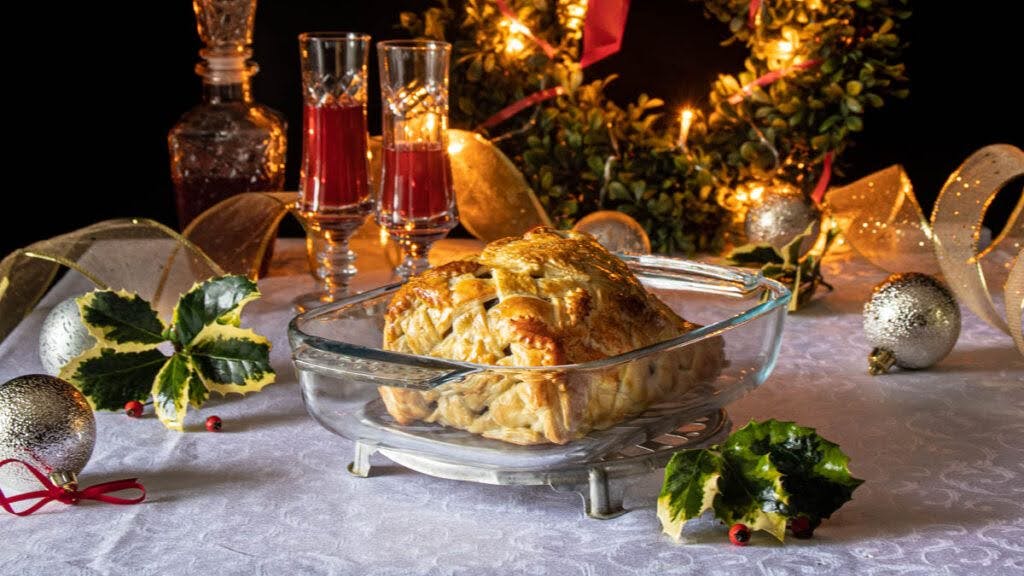

December has arrived, bringing with it the magic of Christmas, the time of year when families come together to share moments and meals around the table.
To warm up the season and take you on a journey filled with Christmas spirit, we’ve prepared a series of four delicious holiday recipes. Last week, we shared the recipe for Neapolitan lasagna. Today, we’ll bring you the recipe for roast in a crust and dive into the story of Santa Claus.
Roast in a crust, whether made with beef or pork, represents a local variation of the renowned Beef Wellington, adapted to Italian ingredients and tastes. While Beef Wellington owes its name and fame to the Duke of Wellington and English tradition, roast in a crust has evolved into a simpler and more accessible interpretation, maintaining the allure of meat wrapped in a crispy, flavorful crust.
Beef Wellington is characterized by its use of puff pastry, mushrooms, and prosciutto, often paired with a Madeira sauce. In contrast, roast in a crust is a versatile dish that reflects Italy's regional culinary traditions: instead of mushroom pâté, it often features vegetables, pancetta, or local cheeses that enhance the flavor of the meat. This reinterpretation highlights the typical flavors of the territory, making it an ideal choice for Sunday lunches or festive dinners.
The dish we’ll guide you through now shares with Beef Wellington the goal of preserving the meat’s juices and creating a contrast between its tender interior and crispy exterior. However, its versatility makes it a more approachable preparation, quicker to make, and adaptable to a variety of occasions and tastes.
This recipe, along with Neapolitan lasagna and chicken liver crostini, forms the savory dishes in our 2024 Christmas menu.
The story of Santa Claus
After preparing this crispy roast in a crust that will fill the house with warm, inviting aromas, it's impossible not to think about the traditions that make the holidays special. Speaking of traditions, do you know the story of Santa Claus and how he became the symbol we know today? Here's a brief journey into the past.
The figure of Santa Claus, beloved by children and a universal symbol of Christmas, has ancient origins rooted in religious, cultural, and folk traditions that have evolved over the centuries.

The Origins: Saint Nicholas of Myra
It all begins with Saint Nicholas, a bishop who lived in the 4th century in Myra, in present-day Turkey. Known for his extraordinary generosity and the miracles attributed to his intercession, Saint Nicholas is especially remembered for the legend of the three poor girls. According to tradition, he gave them bags of gold coins, dropping them through a window or leaving them in stockings hanging to dry, thus saving them from a life of misery. This act is considered the first seed of the Christmas gift-giving tradition. After his death, the cult of Saint Nicholas spread across Europe, turning him into a symbol of generosity.
The Transformation of the Legend
With European migration to the New World, the tradition of Saint Nicholas blended with other cultural influences. In the United States, the figure was redefined in the 19th century, especially thanks to the poem "A Visit from St. Nicholas" (1823), attributed to Clement Clarke Moore. Here, Santa Claus appears as a cheerful, plump figure with a white beard, traveling in a sleigh pulled by eight reindeer, delivering gifts to children on Christmas Eve.
Another key contribution to the creation of his modern image came from Coca-Cola. In the 1930s, the company launched advertising campaigns featuring Santa Claus illustrations by Haddon Sundblom. Sundblom's Santa, with his red and white suit and smiling face, became an image universally recognized.
Symbolic Elements
The North Pole home, the flying sleigh, and the reindeer (including the famous Rudolph, created in 1939) are inventions of popular culture that have enriched the figure of Santa Claus. These details, though lacking historical roots, have helped transform him into a magical, timeless symbol, capable of enchanting both young and old.

A Universal Symbol
Despite his Christian origins, Santa Claus is now a universal figure. He embodies values such as kindness, hope, and generosity; his figure has transcended religious and cultural boundaries, becoming the dominant symbol of the holiday season, even overshadowing any religious figures traditionally linked to the holiday.
